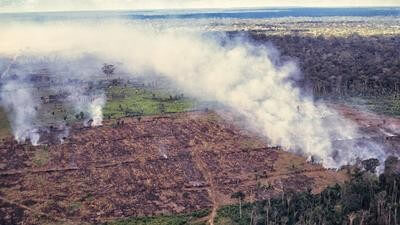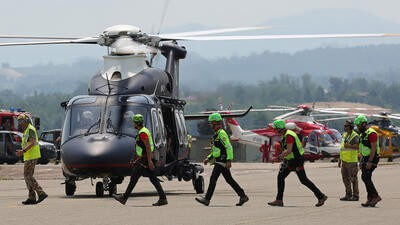To Live or Die? Rescue aircrew survival tactics and techniques

Chris ‘Razor’ Sharpe looks at the misconceptions of what is an essential part of all aircrew training: aircrew survival
‘To Live, or die?’ Sounds like a 007 James Bond movie but ultimately that is what aircrew survival is; live or die.
Within the past 10 plus years, social media videos of survival have become commonplace. Sit at home on your sofa and watch how to survive in a post-crash scenario; start a fire, and skin an animal for food. Television programs often focus on the presenter eating some cooked insects or fish as it makes good TV viewing. Unfortunately, the idealization of this comparative ‘ease’ is far from the truth and leads to a multitude of misconceptions surrounding what aircrew survival, such as:
- Easy
- Not needed
- Not applicable: We can either ‘walk to safety’, or Search and Rescue (SAR) will find us within minutes.
In this article, we will look at these points in reverse.
One of the biggest misconceptions is how quickly you will be rescued.
In accordance with FAA (Federal Aviation Administration) statistics, for an Instrument Flight Rules (IFR) flight plan in the US, the average time last known position (LNK) to rescue is 31 hours. Although, if you do not update flight route corrections (in flight) or file an accurate plan, this can differ considerably.
In aircrew survival, our simplest starting point is the flight plan, and its free!
Without an accurate flight plan Search and Rescue (SAR) teams do not know where to start looking for you. Your ability to survive becomes even more important. Remember – you are not a survivor until you are rescued.
On average, 68 per cent of all aircrews are injured during a crash scenario, so statistically you will not be mobile in the first place. This is compounded by the simple fact that SAR services are looking for your aircraft’s Emergency Locator Transmitter (ELT) – not you.
So, part of ‘prevention’ is to make certain your aircraft ELT is the 405 MHz/121.5 MHz system (as the 121.5 ELT monitoring was turned off in 2019). Ideally you have the aircraft ELT, and the best purchase you can ever make, a personal locator beacon (PLB). Individually registered and accurate, allowing rescue services access to personal information such as who you are, equipment carried, Next of Kin/Point of Contact information etc.
The reliance on electronic aids (such as EFB, GPS and smart phone apps), although super accurate, all have a failure point – cost and the battery. ‘Old school’ paper charts and an E3B flight ‘computer’ (which is in no way a computer) are no longer used frequently, but when systems fail, as an aircrew we have an approximate idea of where we are at least. However, navigation in a non-combat/tactical survival situation should not be a concern, as the golden rule is to STAY WITH THE AIRCRAFT. Use the maps and charts to make a fire.

A real-life example
A Senior Aircrewman at Black Wolf Helicopters, and in my opinion one of the ‘top four’ jungle survival instructors on the planet, even whilst sustaining a fractured wrist, rescued 28 people after mud slides in Peru (and giving his own seat in an aircraft to a survivor).
Although a very experienced Special Forces jungle survival instructor, familiar with the area, after a 10km walk, he realized that as an aircrewman (SAR) he was ‘equipped to survive’ – NOT to take a hike through the surrounding environment. He spent six days at 11.600 feet (MSL) – and despite all his superior survival knowledge he stayed with the aircraft in its last position. After six days, a military helicopter returned to that same location and was successfully signaled by his heliograph mirror.
As aircrew, our aim is to mitigate the TIME from incident to RESCUE, whilst staying ALIVE. Period.
Aircrew survival skills, the same as all ‘ALSE’ (Aviation Life Support Equipment), is fundamentally simple – we never want to use it. This does pose a cost concern for perishable items and is often seen as an unwanted hindrance.
The natural human instinct is ‘fight or flight’ – post crash, we naturally and instinctively want to egress (exit) to safety... ‘If it’s not attached to you – you will not have it’ are all applicable. The aim of phrases such as ‘Dress to Egress’ (dressing adequately for the environment we are flying over – not sat in), is to ensure we have the basic protection and survival aids physically on our person.
Yes, carry an extended survival/medical kit in the aircraft, and I highly recommend that you do so, but to put into perspective - for those that have ever done Underwater Egress Training, considering that 76 per cent of all ditchings are on inland waters are you going to successfully egress, and then try and swim around in a sinking metal box looking for your kit? No, you are not, simply because your body’s natural reactions will be to egress to the surface.

In short, no, it isn’t. I have many very experienced aircrews that are confident that they can walk out (post-crash), kill a deer/monkey, and survive.
No, you cannot, is the simple answer. For example, as an aircrew survival instructor – I can literally destroy any preconceptions of survival being easy, even in your own garden on a sunny day.
The two main misconceptions in a survival situation are navigation as discussed, and making food a priority. Totally incorrect.In survival situations, proven time and time again, we must follow what is referred to as the ‘law of 3’s’: Whether operating over water or solely inland, these ‘laws/rule of 3’ have an intrinsic effect on how we as aircrew equip, train, and prepare to survive.
- 3 seconds following a bad decision
- 3 minutes without oxygen
- 3 hours in extreme temperatures
- 3 days without water
- 3 weeks without food
From this set of laws, we arrive at our actual ‘priorities of survival’, in this order:
- PROTECTION
- LOCATION
- WATER
- FOOD
Do not deviate or change because you or someone else thinks they 'know better’. These priorities have stood the test of time for many years.
We need to protect ourselves from further injury/harm – egress the aircraft to a safe distance, provide first aid and erect a shelter to protect from the elements. This takes a long time, as we are already on a downward curve for our body’s energy supplies.
'Fifty thousand ways to start a fire and a PLB’ – we need to start a fire, not a beach BBQ fire. Small enough to keep us warm, but also ready instantly for signaling purposes. Once we have our basic shelter and fire, we can then sit and relax. Lay out all your survival equipment and take stock of your situation. Open your signaling gear, check it still works, refresh yourself on the instructions. A SAR helicopter passing overhead is not the time to realize that you cannot remember how to operate your equipment. From that point it is all about improving what we have done. Remember this is survival and we are not on a camping trip. If you are bored, you don’t have enough firewood.
So how do we as individuals or units/ companies practice these skills?
Firstly, don’t just buy an off the shelf survival kit. The same goes for survival manuals/books; many are generic and not specific to the region we are operating in, therefore contain far too many skills and techniques. Survival kits should be adjusted according to the region and climate of operations and be of the highest quality your budget can afford. Have an intrinsic knowledge of your:
- ‘Aids to location’
- Mayday calls, frequencies, and operation of radios
- 7700 Emergency Transponder
- Aircraft ELT
- Individual PLB
- Rescue lasers
- Heliograph signal mirrors, whistles, chem lights, strobes, marker panels
- Fifty thousand ways to start a fire’
Fire applies to all of the priorities of survival: protection, location, water and food so try as many methods as you can. Also learn the different types of fire:
- Butane lighter
- Ferrous rods
- Chemical reactions
- Matches
- Creation of a signal ‘Pyramid’ (a means of instantly creating signal smoke from a small fire).
Then practice. Ideally, survival training should be done when you are cold, wet, tired, and hungry. Practically that is often not achievable for organizations’ due to manning/staffing levels. So, try it outside in the parking lot. Walk 20 meters into a field, sit down and start a fire with whatever you have on your person or can reach without moving. It is the muscle memory of systems we need to develop. Know how to use your equipment, in order of the priorities of survival, and in any weather (day or night).
On our courses we issue, and I personally recommend developing your own, ‘Aircrew survival checklist’. As with all Crew Resource Management (CRM) checklists, designed for high stress/ cognitive overload situations, it allows you to sit down, temporarily relax, and formulate a plan. The key to all survival situations is the WILL TO SURVIVE.
It is your life, prepare yourself appropriately.
Master the basics and remember, knowledge weighs nothing.

August 2022
Issue
In our August issue of AirMed&Rescue we look at survival, sustainability, and performance; both in the air and on the ground.
Chris Sharpe
Chris Sharpe is a contributor for the education company Heavy Lies the Helmet. His experience includes Project Manager, Chief Aircrewman, and Flight Paramedic for HeliSOS HEMS/Rescue Helicopter in Guatemala, and the Chief Aircrewman at Black Wolf Helicopters. Sharpe has been flying for over 28 years; having over 15,000 flying hours and 6,000 rescue operations to his credit. He is a safety and survival expert, teaching survival techniques to both civilian and military helicopter crews in Guatemala. He is also the recipient of the HAI 2019 Salute to Excellence Safety Award.




